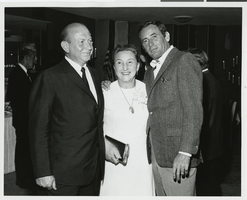Search the Special Collections and Archives Portal
Search Results
Dr. Agnes Lockette oral history interview
Identifier
Abstract
Oral history interview with Dr. Agnes Lockette conducted by Dennis McBride on March 25, 1996 for the Boulder City Library Oral History Project. In the interview, Lockette discusses her experiences teaching in the Clark County, Nevada School District (CCSD) and at the University of Nevada, Las Vegas (UNLV). Lockette begins by talking about studying at Albany State College in Albany, Georgia, moving around the United States due to her husband's military service, and finally settling in Boulder City, Nevada in 1953. She also discusses racial integration in CCSD and in her own classrooms at the Westside School (Las Vegas Grammar School) and C. T. Sewell Elementary School during the 1960s. Other subjects Lockette covers include the expansion of the Las Vegas, Nevada hotel and casino industries in the early 1950s, the increasing student population, teaching conditions, and other educators in Las Vegas including Mabel Hoggard and James Dickinson. Lastly, Lockette recalls her experiences with UNLV, community support and engagement for education, and working toward her master's and doctoral degrees in English.
Archival Collection
Dr. Ruben Acherman oral history interview
Identifier
Abstract
Oral history interview with Ruben Acherman conducted by Monserrath Hernandez and Laurents Bañuelos-Benítez on July 18, 2019 for the Latinx Voices of Southern Nevada Oral History Project. In this interview, Acherman discusses growing up in Palmira, Colombia, where his father emigrated to from Romania. He talks about how accepted he felt in a Catholic community, moving to Cali, Colombia to study medicine, and describes completing his rural residency in San Pedro, Colombia. Acherman then recalls specializing in cardiology at the University of Southern California (USC). Later, Acherman explains why he chose to specialize in cardiology, his interests in pediatric cardiology, and his inability to continue studying due to the lack of financial stability and his immigration status. Acherman describes his move to the Summerlin residential community in Las Vegas, Nevada after being offered a position to work for Dr. Bill Evans in 2001, and compares the differences in health care between the United States and Columbia. Lastly, Acherman discusses his first balloon dilation procedure and talks about the illustrations he has created in cardiology textbooks.
Archival Collection
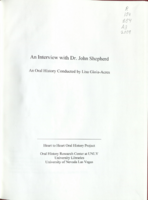
Transcript of interview with Dr. John Shepherd by Lisa Gioia-Acres, November 21, 2008
Date
Archival Collection
Description
Dr. John Richard Shepherd shares the background of his early life in southern Illinois, his father's and grandfather's occupations, and his educational journey through college and medical school. His army experiences in Chicago and Alabama convinced him and his wife to look for a warm dry climate in which to live, and they relocated to Las Vegas in 1968. Dr. Shepherd recalls the businesses and housing surrounding Sunrise Hospital, the difficulties getting his specialty listed in the phone book, and renting his first office space from Nate Adelson. He also describes taking out a loan to install ophthalmology equipment, hiring an office manager with medical accounting experience, and doing cataract surgery in a way that basically hadn't changed for decades. The passing of the Medicare bill back in 1966 caused Dr. Shepherd's practice to build up quickly. He details the many ways eye surgery changed, including the invention of the intraocular lens and the phacoemulsification procedure. He mentions his and Dr. Shearing's contributions to ophthalmology — better designed lenses and surgical techniques - which they taught to other doctors from all over the country. Dr. Shepherd discusses radial keratotomy, which was a precursor to laser and later LASIK surgery, and describes a lens implant technique he learned in Russia from Dr. Fyodorov. He goes on to share anecdotes and stories of his interactions with patients, his travels as a consultant and as a surgical teacher for Project Orbis, and meeting Fidel Castro. He speaks candidly about his successes and his failures as well. Dr. Shepherd retired in 2006 and immediately enrolled in a Master's program and earned a degree in military history. After a long and distinguished career, after receiving many accolades and awards, he and his wife are enjoying life, splitting their time between Sun Valley, Idaho, and Las Vegas.
Text
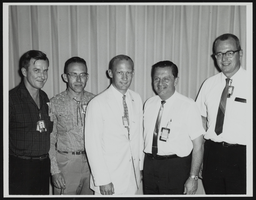
Dr. P. W. Davidson, Dr. H. T. Knight, Major Edwin "Buzz" Aldrin, Howard Cannon, and Chief Bob P. Helgeson at the Space Nuclear Propulsion Office at the Nuclear Rocket Development Station: photographic print
Date
Archival Collection
Description
Image
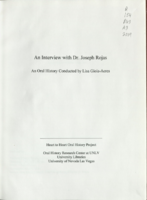
Transcript of interview with Dr. Joseph Rojas by Lisa Gioia-Acres, September 30, 2008
Date
Archival Collection
Description
Dr. Joseph Rojas, born 1933 in Alexandria, Louisiana, was the son of Joseph Edward Rojas and wife Carroll. He graduated high school at age 16 and entered Loyola University of the South. Two years later he was accepted at Louisiana State University School of Medicine, graduating with a medical degree in 1957. He interned at Charity Hospital and then completed his OB-GYN residency at Tulane University. Several mentors worked with Dr. Rojas during his residency and he recalls learning surgical and bed-side skills from the likes of Dr. Lynn White and Dr. Fred Janson. He also remembers the very high volume of patients - up to 300 - that he and other residents saw daily. Dr. Rojas married Mona Robicheaux, RN, during his residency and afterwards joined the Air Force. He and his family — they eventually had six children — were stationed at Nellis Air Force Base, arriving in Las Vegas in 1961. He was chief of OBGYN and deputy hospital commander while at Nellis and then served as chief of OBGYN at Southern Nevada Memorial Hospital until 1972. He later served as chief of staff at Women's Hospital and Valley Hospital, and was the first chief of staff at Summerlin Hospital. Dr. Rojas also maintained a private practice outside of the hospital. His wife worked alongside him in his office, and they share memories and anecdotes of the patients they saw and the general atmosphere of the medical community. Both Joseph and Mona agree that Las Vegas hospitals were less racially segregated than the hospitals in Louisiana, and felt that the West was more open to integration. In 1966 Dr. Rojas started the first OB-GYN residency in Nevada, which led to the development of the University of Nevada School of Medicine. He was a researcher, lecturer, teacher, and author. He earned many awards, including the Harold Feikes MD Award for Outstanding Physician in Clark County (2001), and the Nevada State Medical Association Distinguished Physician Award (1980). Dr. Rojas passed away in May of 2009, leaving behind an incredible legacy of service to the residents of Clark County.
Text

Transcript of interview with Dr. Harrie Fox Hess by Scot Siegel, February 26, 1979
Date
Archival Collection
Description
On February 26th, 1979, Scot Siegel interviewed his psychology professor, Dr. Harrie Hess (born March 1, 1929 in Hammond, Indiana) in his office at the University of Nevada, Las Vegas. Dr. Hess discusses his family’s reason for moving to Nevada and how he felt as a young adult moving to Las Vegas. The two go on to talk about Dr. Hess’ contributions to Nevada through his work as a psychologist, and briefly mentions the first law to be drafted on psychology certification in Nevada. Dr. Hess then describes the Wild Cat Lair as an important site of social recreation for early Las Vegas youth. The interview concludes with his memory of Boulder (Hoover) Dam and how he believes that workers from the Great Depression paved the way for industrial success in gambling due to their employment on the Dam.
Text
Audio clip 2 from interview with Dr Ed Goldman, April 4, 2016
Description
Dr. Goldman discusses the lawsuit and ensuing "war" that resulted in the school district hiring more minorities in teacher and administrator positions.
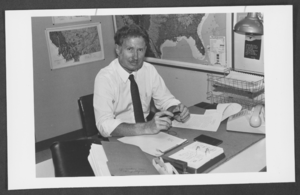
Photograph of Dr. Lawrence Dandurand, Las Vegas, Nevada, 1981
Date
Archival Collection
Description
Image
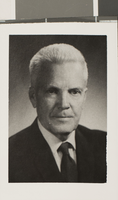
Photograph of Dr. David Bruce Dill, circa 1970s-1980s
Date
Archival Collection
Description
A photograph of Dr. David Bruce Dill at the University of Nevada, Las Vegas (UNLV).
Image

